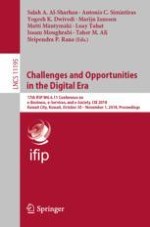2018 | Buch
Challenges and Opportunities in the Digital Era
17th IFIP WG 6.11 Conference on e-Business, e-Services, and e-Society, I3E 2018, Kuwait City, Kuwait, October 30 – November 1, 2018, Proceedings
herausgegeben von: Salah A. Al-Sharhan, Antonis C. Simintiras, Yogesh K. Dwivedi, Marijn Janssen, Matti Mäntymäki, Luay Tahat, Issam Moughrabi, Taher M. Ali, Dr. Nripendra P. Rana
Verlag: Springer International Publishing
Buchreihe : Lecture Notes in Computer Science
